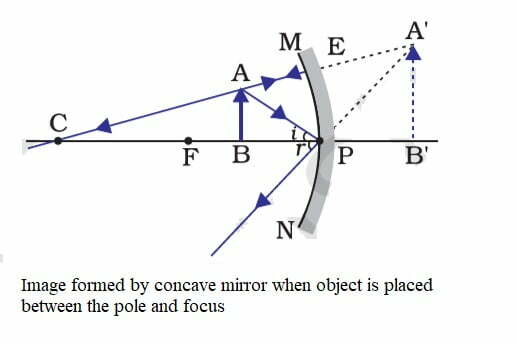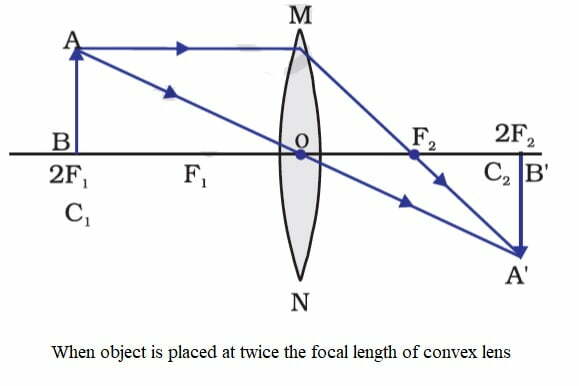Light Reflection and Refraction NCERT Questions Solution
1. Which one of the following materials cannot be used to make a lens?
(a) Water (b) Glass (c) Plastic (d) Clay
ANSWER: For lens manufacturing material should be transparent here clay is a non-transparent material, so we cannot use it to make lens while water, glass and plastic (may be) are transparent materials so we can use them to make lens.
2. The image formed by a concave mirror is observed to be virtual, erect and larger than the object. Where should be the position of the object?
(a) Between the principal focus and the centre of curvature
(b) At the centre of curvature
(c) Beyond the centre of curvature
(d) Between the pole of the mirror and its principal focus.
ANSWER:(c)
When object is placed between the pole of the concave mirror and its principal focus image formed is virtual, erect and larger than the object.

Table of Contents

3. Where should an object be placed in front of a convex lens to get a real image of the size of the object?
(a) At the principal focus of the lens
(b) At twice the focal length
(c) At infinity
(d) Between the optical centre of the lens and its principal focus.
ANSWER: (b)
To get a real image of the size of the object, an object should be placed at twice the focal length of convex lens.
4. A spherical mirror and a thin spherical lens have each a focal length of –15 cm. The mirror and the lens are likely to be
(a) both concave.
(b) both convex.
(c) the mirror is concave and the lens is convex.
(d) the mirror is convex, but the lens is concave.
ANSWER: Option (c). Concave mirror and convex lens both have negative focal length because their focus lies on left hand side of pole.
6. Which of the following lenses would you prefer to use while reading small letters found in a dictionary?
(a) A convex lens of focal length 50 cm.
(b) A concave lens of focal length 50 cm.
(c) A convex lens of focal length 5 cm.
(d) A concave lens of focal length 5 cm.
ANSWER: Option (c). I prefer convex lens because it forms virtual image and smaller focal length because it have high power.
7. We wish to obtain an erect image of an object, using a concave mirror of focal length 15 cm. What should be the range of distance of the object from the mirror? What is the nature of the image? Is the image larger or smaller than the object? Draw a ray diagram to show the image formation in this case.
ANSWER: If we wish to obtain an erect image of an object, using a concave mirror, object must be placed between its pole (P) and the principal focus (F). So, range of object distance = 0 cm to15 cm (pole to focus). Nature of image virtual, erect, and magnified in nature, as shown in the below figure.

8. Name the type of mirror used in the following situations.
(a) Headlights of a car.
(b) Side/rear-view mirror of a vehicle.
(c) Solar furnace.
Support your answer with reason
Answer: (a) A concave mirror is used in the headlights of a car because it produces a parallel beam of light (which travels far distances) when the light source is placed at its principal focus.
(b) A convex mirror is used as a side or rear view mirror of a vehicle because it produces a virtual, erect, and diminished image of the objects placed in front of it so that you get a wide field of view. It enables the driver to see traffic behind him.
(c) A concave mirror is used to construct solar furnaces because it converges the light incident on them at a single point, ‘the principal focus’, so that they can be used to produce a large amount of heat at that point.
9. One-half of a convex lens is covered with a black paper. Will this lens produce a complete image of the object? Verify your answer experimentally. Explain your observations.
Answer: If one-half of a convex lens is covered with black paper, then it will produce a complete image of the object, but the image may be less bright as less light is used to produce it.

10. An object 5 cm in length is held 25 cm away from a converging lens of focal length 10 cm. Draw the ray diagram and find the position, size and the nature of the image formed.
Answer: Given: object height h1= 5cm, u = 25 cm, f = 10 cm

11. A concave lens of focal length 15 cm forms an image 10 cm from the lens. How far is the object placed from the lens? Draw the ray diagram.

12. An object is placed at a distance of 10 cm from a convex mirror of focal length 15 cm. Find the position and nature of the image.
13. The magnification produced by a plane mirror is +1. What does this mean?
Answer: Magnification (m) produced by a plane mirror = +1
👉 Magnification (m) = height of image (h2) / height of object (h1)
m = +1 = height of image (h2) / height of object (h1)
So, height of image (h2) = height of object (h1)
Since magnification is positive, the image formed is virtual and erect.
14. An object 5.0 cm in length is placed at a distance of 20 cm in front of a convex mirror of radius of curvature 30 cm. Find the position of the image, its nature and size.
15. An object of size 7.0 cm is placed at 27 cm in front of a concave mirror of focal length 18 cm. At what distance from the mirror should a screen be placed, so that a sharp focused image can be obtained? Find the size and the nature of the image.
16. Find the focal length of a lens of power – 2.0 D. What type of lens is this?
Answer: Given: Power of lens = -2.0 D
👉 Power of lens = 1 / focal length of the lens
Focal length of the lens = 1 / Power of lens = 1 / (-2.0) = – 0.5 m
Since the power of the lens (-2.0) is negative, the lens is diverging or concave in nature.
17. A doctor has prescribed a corrective lens of power +1.5 D. Find the focal length of the lens. Is the prescribed lens diverging or converging?
Answer: Given: Power of lens = +1.5 D
👉 Power of lens = 1 / focal length of the lens
Focal length of the lens = 1 / Power of lens = 1 / 1.5 = 0.66 m
Since the power of the lens (+1.5D) is positive, the lens is converging or convex in nature.
MY YouTube Channel Link : 👉🖱 https://www.youtube.com/channel/UCGpC7nWE0-bBv9I53MM8qjQ
Light Reflection and Refraction NCERT Questions Solution, Light Reflection and Refraction NCERT Questions Solution, Light Reflection and Refraction NCERT Questions Solution, Light Reflection and Refraction NCERT Questions Solution, Light Reflection and Refraction NCERT Questions Solution, Light Reflection and Refraction NCERT Questions Solution, Light Reflection and Refraction NCERT Questions Solution, Light Reflection and Refraction NCERT Questions Solution, Light Reflection and Refraction NCERT Questions Solution, Light Reflection and Refraction NCERT Questions Solution
Light Reflection and Refraction NCERT Questions Solution, Light Reflection and Refraction NCERT Questions Solution, Light Reflection and Refraction NCERT Questions Solution, Light Reflection and Refraction NCERT Questions Solution, Light Reflection and Refraction NCERT Questions Solution, Light Reflection and Refraction NCERT Questions Solution, Light Reflection and Refraction NCERT Questions Solution, Light Reflection and Refraction NCERT Questions Solution, Light Reflection and Refraction NCERT Questions Solution, Light Reflection and Refraction NCERT Questions Solution